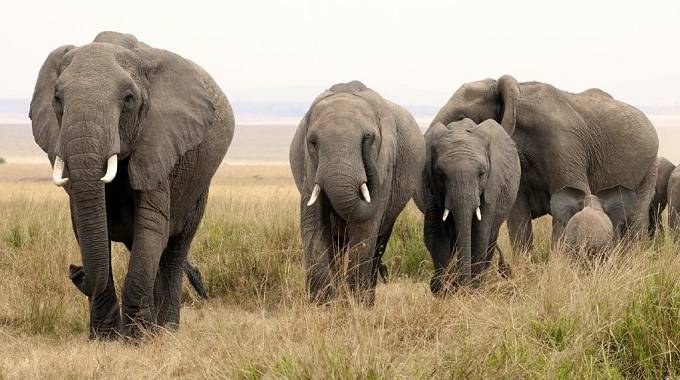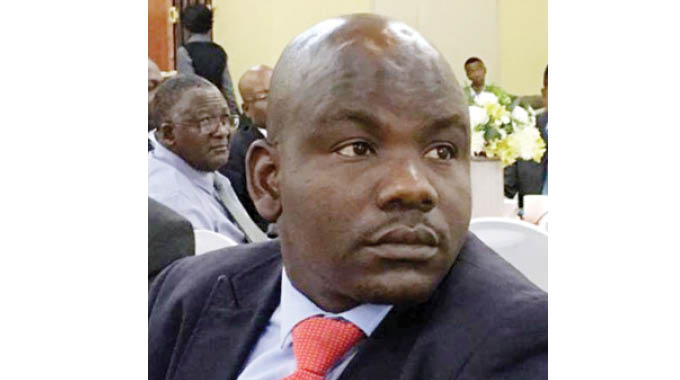Hunting, agriculture used uniquely to reduce poaching in Zambian community

Emmanuel Koro
About 45 years later, Zambia’s implementation of wildlife anti-poaching strategies has helped to increase South Luangwa’s elephant population and the culture of community wildlife and habitat conservation.
Wildlife in Luangwa suffered heavy poaching that reduced big elephants herds from 90 000 in 1975 to about 1 000 by 1988.
Hunting in communities that co-exist with wildlife and also sustainable agriculture in neighbouring communities that don’t benefit from hunting at all and therefore pose a threat to wildlife through poaching are the two magic bullets strategically used to ‘shoot down’ the rate of poaching in South Luangwa.
The Luangwa Integrated Rural Development Project (LIRDP) community based natural resources management (CBNRM) programme endorsed the need for the local communities to benefit from their wildlife, in order to incentivise and increase community involvement in wildlife anti-poaching activities and habitat conservation. The LIRDP was initiated as a response to the wildlife poaching crisis and shares the South Luangwa anti-poaching and habitat conservation success story.
According to Zambia’s Great elephant census of 2014-2015, 15 750 elephants were found in the natural boundaries of the South Luangwa National Park where they co-exist with rural communities. Unfortunately, the rhino had been decimated before the start of the LIRDP community wildlife management approach that later evolved into a CBNRM programme popularly known as the Administrative Management Design for Game Management (ADMADE) programme.
This was a continuation of the LIRDP community wildlife management approach, but this time being applied nationally, including in South Luangwa.
The Zambian government introduced the ADMADE programme in 1983. Its key features are the training and hiring of village scouts, using 50% of safari hunting revenue to finance community projects, and game culling that provides game meat for the community. By 1996 South Luangwa had already wisely used revenue from hunting to build a community-based wildlife management training college, Nyamaluma College.
Wildlife conservation in South Luangwa was a stage by stage process. The socioeconomic benefits from hunting quickly brought a pro-wildlife conservation mindset change to the South Luangwa residents that co-existed with wildlife.
“Within the South Luangwa the double-gain from wildlife revenues has caused a large and important shift in community attitudes toward wildlife conservation (and undoubtedly also in their own sense of self-worth),” observes Oxford University-educated environmental economist Dr Brian Child and Cassandra Bergstrøm in a recent research paper, Testing Indicators of Sustainable Use in a Case Study of South Luangwa.
Indicators of the South Luangwa hunting communities’ wildlife conservation success later started showing through wildlife populations growth. This was evidenced by the sighting of bushbucks that were never seen in the villages where they were previously poached for the pot.
“With dwindling resources and loss of habitat for wildlife, we believe that hunting is one of the main pillars of conservation and that the management and utilisation of wildlife is one of the most important tools in conserving wildlife for our children and future generations,” said the Zambian Professional Hunters Association in a recent statement. “To this end, we advocate and collaborate in every possible manner with the Government of Zambia and its Ministry of Tourism and Arts, or their equivalent, in all matters concerning the conservation of Zambia’s flora and fauna, which is consistent with the practice of hunting…”
Zambia’s South Luangwa National Park and the adjoining Game Management Areas (GMAs) are endowed with the country’s richest wildlife populations. Hunting takes place outside the national parks in the game management areas.
Apart from the poaching threat, the expanding human population in the South Luangwa needed to be addressed as fears grew that mankind would eventually take up all the land set aside for wildlife conservation and potentially harm wildlife. Family planning was identified as a solution to the problem. Although South Luangwa communities had long resisted family planning they later impressively accepted it, after having to enjoy the socio-economic benefits from hunting revenue.
“Before the villagers started benefiting from the ADMADE programme, it was difficult to convince them that human population increase would negatively affect the use of natural resources and the people’s own welfare,” said Mr Andrew Phiri of Nyamaluma Institute of South Luangwa that specialises in community-based natural resources management training.
Although the communities that were enjoying benefits from hunting revenue had long converted from wildlife poachers to wildlife conservationists, the outsider poaching threat from far away communities that didn’t benefit from hunting still needed to be addressed.
“High levels of rural poverty in the Luangwa Valley left villagers with few options to make ends meet,” said Dr Child and Cassandra Bergstrøm. “Crop yields were low, and farmers had limited or no access to outside markets. Without another way to make an income, people turned to illegal wildlife poaching and charcoal making to feed their families.
As a result, the outsider threat to cause wildlife populations decline and the disappearance of forests continued.”
The challenge was how to find out more innovative ways to cultivate the anti-poaching culture, beyond South Luangwa communities that were benefiting from hunting. In came the Community Markets for Conservation (COMACO) with a unique systems approach to support wildlife conservation through teaching poachers sustainable agriculture and providing markets for their crops.
They called their strategy Poacher Transformation. The crop yields dramatically increased. Today, the farmers do not only grow enough nutrient-rich food crops to feed their families but are also producing enough surplus to sell.
COMACO buys the surplus crops from them at premium market prices and the processes them into its famous It’s Wild! brand. The COMACO market intervention provides thousands of families with a reliable income source and removes the economic driver for wildlife poaching and timber harvesting.
“Thanks to the consumers of It’s Wild! products, lives are improving for small-scale farmers and elephant populations are on the rise,” said COMACO in a recent statement. “The Poacher Transformation programme has reformed poachers to become some of Zambia’s fiercest advocates for both wildlife and habitat conservation.”
Meanwhile, local and international observers say that the COMACO wildlife conservation systems approach that economically empowers outsider communities with sustainable agriculture skills to discourage them from poaching has arguably not been practised anywhere else in the world.
As crop yields started to increase, COMACO began purchasing crops in remote regions where no one else would buy and paying farmers premium market prices. It then processes the agricultural produce into high-value food products, which it sell across Zambia under the brand It’s Wild! and return all proceeds to their farmer support services.
“By creating a market where there was none, we’ve made conservation profitable,” said COMACO in a statement highlighting the success of this unique conservation approach. “Benefiting from both higher yields and cash payment, our farmers are highly motivated to conserve.”
It’s Wild! classics, such as our peanut butter, honey, rice, and Yummy Soy can be found at all major Zambian supermarkets. The crops are organically grown. The COMACO programme employs over 300 Zambians and buys agricultural produce from 179 000 farmers. This programme contributes US$4.5 million annually to Zambia’s economic growth.
“So much has happened and so many new strategies that ADMADE gave birth to,” said COMACO CEO and founder, Dr Dale Lewis in response to questions on how South Luangwa communities had progressed in their conservation efforts over the years.
Despite all the necessary wildlife conservation systems in place, the hunting industry in Zambia was recently threatened by the most unlikely source. In 2019, trophy hunting in Zambia was threatened with suspension following Community Resource Boards (CRBs) protests against the government’s non-payment of concession fees since 2016 and no hunting revenue since 2018.
“We are immediately calling for the suspension of the hunting activities in all hunting blocks of Zambia,” said a 2019 statement issued by the CRBs. “We as signatories to the hunting concession agreement have withdrawn our support – making the existing agreements null and void. We would be working with our community scouts and community members to prevent any further hunt until the matter is resolved. All hunting camps in GMAs will be secured to block any attempt to re-open hunting.”
While the Zambian CRBs’ protest statement might have been viewed as an impressive rural community awareness to demand and defend their rights to benefit from hunting, the threat that the Zambian Government posed to the hunting industry and by implication wildlife conservation, as well as the wellbeing of hunting communities, was widely viewed as regrettable.
“Good to see the communities standing up for their rights,” said Gail Potgeieter, a researcher on wildlife management issues. “They should be paid directly for the use of their land for hunting or any other purpose.
Hopefully, this action will have the right response by the government to follow through on their promises.”
However, the animal rights movement is by far the biggest threat to Zambia’s hunting industry. They recently mobilised communities to again threaten to shut down the hunting industry based on lies that, “they are receiving inadequate benefit from wildlife.”
Contrary to the ongoing Western animal rights groups’ lies that hunting is threatening wildlife populations in Africa, the lesson learnt from South Luangwa is that the socio-economic benefits from hunting are incentivizing wildlife and habitat conservation.
At the 11th meeting of UN Convention on International Trade In Endangered Species of Fauna and Flora Species (CITES) (COP11) held in Nairobi, Kenya (10-20 April 2000), the CITES Secretariat publicly rejected the Western animal rights groups’ claims that legal trade in wildlife, including trophy hunting imports lead to poaching and illegal trade.
About the writer: Emmanuel Koro is a Johannesburg-based international award-winning environmental journalists who writes extensively on environment and development issues in Africa











Comments